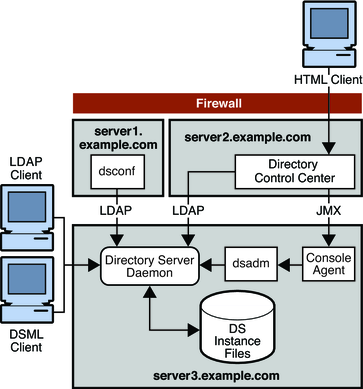| Skip Navigation Links | |
| Exit Print View | |

|
Oracle Directory Server Enterprise Edition Deployment Planning Guide 11g Release 1 (11.1.1.5.0) |
| Skip Navigation Links | |
| Exit Print View | |

|
Oracle Directory Server Enterprise Edition Deployment Planning Guide 11g Release 1 (11.1.1.5.0) |
Part I Overview of Deployment Planning for Directory Server Enterprise Edition
1. Introduction to Deployment Planning for Directory Server Enterprise Edition
2. Business Analysis for Directory Server Enterprise Edition
Part II Technical Requirements
3. Usage Analysis for Directory Server Enterprise Edition
4. Defining Data Characteristics
5. Defining Service Level Agreements
6. Tuning System Characteristics and Hardware Sizing
7. Identifying Security Requirements
8. Identifying Administration and Monitoring Requirements
9. Designing a Basic Deployment
Improving Performance in a Basic Deployment
Using Indexing to Speed Up Searches
Optimizing Cache for Search Performance
All Entries and Indexes Fit Into Memory
Sufficient Memory For 32-Bit Directory Server
Optimizing Cache for Write Performance
10. Designing a Scaled Deployment
11. Designing a Global Deployment
12. Designing a Highly Available Deployment
Part IV Advanced Deployment Topics
13. Using LDAP-Based Naming With Solaris
14. Deploying a Virtual Directory
A basic Directory Server Enterprise Edition deployment includes the following elements:
Directory Server instance files
Directory Server daemon
dsadm and dsconf command-line utilities
Directory Service Control Center (DSCC), if GUI access is required
Console Agent, if DSCC is used
These elements can all be installed on a single machine. The following figure illustrates the high-level architecture of a basic Directory Server Enterprise Edition deployment.
Figure 9-1 Basic Directory Server Enterprise Edition Architecture on a Single Machine

In this scenario, internal LDAP and DSML clients can be configured to access Directory Server directly. External HTML clients can be configured to access DSCC over a firewall.
Although all of the components described previously can be installed on a single machine, this is unlikely in a real deployment. A more typical scenario would be the installation of DSCC and the dsconf command-line utility on separate remote machines. All Directory Server hosts could then be configured remotely from these machines. The following figure illustrates this more typical scenario.
Figure 9-2 Basic Directory Server Enterprise Edition Architecture With Remote Directory Service Control Center

The Directory Server instance stores server and application configuration settings, as well as user information. Typically, server and application configuration information is stored in one suffix of Directory Server while user and group entries are stored in another suffix. A suffix refers to the name of the entry in the directory tree, below which data is stored.
Directory Service Control Center (DSCC) is a centralized, web-based user interface for all servers. DSCC locates all servers and applications that are registered with it. DSCC displays the servers in a graphical user interface, where you can manage and configure the servers. The Directory Service Control Center might not be required in a small deployment because all functionality is also provided through a command-line interface.
In the chapters that follow, it is assumed that the Directory Service Control Center is installed on a separate machine. This aspect of the topology is not referred to again in the remaining chapters.